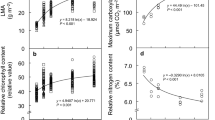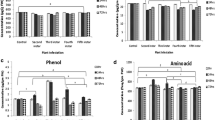Abstract
The present work showed that spider mite-infested leaves placed in the light were more attractive to predatory mites than the infested leaves placed in the dark; furthermore, an increase in the light intensity enhanced this attractiveness. However, the increase of the light intensity did not change the attractiveness of the uninfested leaves to predatory mites. The capacity of cyanide-resistant respiration and the photosynthetic rates of both the infested and uninfested leaves increased with increasing light intensities, whereas the photosystem (PS) II chlorophyll (Chl) fluorescence decreased. The increase of the capacity of cyanide-resistant respiration in the infested leaves was more dramatic than that in the uninfested leaves, whereas the values of photosynthetic rates and Chl fluorescence were lower in the infested leaves than those in the uninfested leaves. Treatment of the infested and uninfested leaves with 1 mM salicylhydroxamic acid (SHAM, an inhibitor of cyanide-resistant respiration) decreased photosynthetic rates and caused further reductions in PSII fluorescence, especially under a higher light intensity. In contrast, the effects of SHAM on PSII fluorescence parameters and photosynthetic rates of the infested leaves were more dramatic than on those of the uninfested leaves. The treatment with SHAM did not significantly change the attractiveness of the infested or uninfested leaves to the predatory mites under all of the light intensities tested. These results indicated that cyanide-resistant respiration was not directly associated with the light-induced attraction of predators to plants, but it could play a role in the protection of photosynthesis. Such role might become relatively more important when photosynthesis is impaired by herbivores infestation.
Similar content being viewed by others
Abbreviations
- AOX:
-
alternative oxidase
- D:
-
dark
- L:
-
low-light treatment
- H:
-
high-light treatment
- HEPES:
-
4-(2-hydroxyethyl)-1-piperazineethanesulfonic acid
- HIPVs:
-
herbivore-induced plant volatiles
- IL:
-
infested leaves
- F0′:
-
minimal fluorescence of the light-adapted state
- Fm′:
-
light-adapted maximum fluorescence yield
- Fq′/Fm′:
-
the PSII operating efficiency
- Fq′/Fv′:
-
PSII efficiency factor
- Fv′/Fm′:
-
PSII maximum efficiency
- Fs :
-
fluorescence yield at the steady-state photosynthesis
- KCN:
-
potassium cyanide
- PSII:
-
photosystem II
- PAR:
-
photosynthetically active radiation
- P N :
-
photosynthetic rate
- SD:
-
standard deviation
- SHAM:
-
salicylhydroxamic acid
- Valt :
-
capacity of cyanide-resistant respiration
- Vt :
-
total respiration rate
- UL:
-
uninfested leaves
References
Allen, J.F.: Photosynthesis of ATP-electrons, proton pumps, rotors, and poise. — Cell 110: 273–276, 2002.
Amor, Y., Chevion, M., Levine, A.: Anoxia pretreatment protects soybean cells against H2O2-induced cell death: possible involvement of peroxidases and of alternative oxidase. — FEBS Lett. 477: 175–180, 2000.
Arimura, G.-I., Matsui, K., Takabayashi, J.: Chemical and molecular ecology of herbivore induced plant volatiles: proximate factors and their ultimate functions. — Plant Cell Physiol. 50: 911–923, 2009.
Baker, N.R., Harbinson, J., Kramer, D.M.: Determining the limitations and regulation of photosynthetic energy transduction in leaves. — Plant Cell Environ. 30: 1107–1125, 2007.
Baker, N.R., Oxborough, K.: Chlorophyll fluorescence as a probe of photosynthetic productivity. — In: Papageorgiou, G.C., Govindjee (ed.): Chlorophyll a Fluorescence: A Signature of Photosynthesis. Pp. 65–82. Springer Verlag, Dordrecht 2004.
Bartoli, C.G., Gomez, F., Gergoff, G., et al.: Up-regulation of the mitochondrial alternative oxidase pathway enhances photosynthetic electron transport under drought conditions. — J. Exp. Bot. 56: 1269–1276, 2005.
Bingham, I.J., Farrar, J.F.: Activity and capacity of respiration pathways in barley roots deprived of inorganic nutrients. — Plant Physiol. Biochem. 27: 847–854, 1989.
Bolton, M.D.: Primary metabolism and plant defense-fuel for the fire. — Mol. Plant Microbe Interact. 22: 487–497, 2009.
Carretero-Paulet, L., Ahumada, I., Cunillera, N. et al.: Expression and molecular analysis of the ArabidopsisDXR gene encoding 1-deoxy-d-xylulose 5-phosphate reductoisomerase, the first committed enzyme of the 2-C-methyl-derythritol 4-phosphate pathway. — Plant Physiol. 129: 1581–1591, 2002.
Chivasa, S., Carr, J.P.: Cyanide restores N gene-mediated resistance to tobacco mosaic virus in transgenic tobacco expressing salicylic acid hydroxylase. — Plant Cell 10: 1489–1498. 1998.
Dat, J., Vandenabeele, S., Vranová, E., et al.: Dual action of the active oxygen species during plant stress responses. — Cell Mol. Life Sci. 57: 779–795, 2000.
Degenhardt, J.: Indirect defense responses to herbivory in grasses. — Plant Physiol. 149: 96–102, 2009.
Dicke, M., van Poecke, R.M.P., de Boer, J.G.: Inducible indirect defence of plants: from mechanisms to ecological functions. — Basic Appl. Ecol. 4: 27–42. 2003.
Farag, M.A., Paré, P.W.: C6-Green leaf volatiles trigger local and systemic VOC emissions in tomato. — Phytochemistry 61: 545–554, 2002.
Feng, H.Q., Wang, Y.F., Li, H.Y., et al.: Salt stress-induced expression of rice AOX1a is mediated through an accumulation of hydrogen peroxide. — Biologia 65: 868–873, 2010.
Gouinguené, S.P., Turlings, T.C.J.: The effects of abiotic factors on induced volatile emissions in corn plants. — Plant Physiol. 129: 1296–1307, 2002.
Kerchev, P.L, Fenton, B, Foyer, C.H., Hancock, R.D.: Plant responses to insect herbivory: interactions between photosynthesis, reactive oxygen species and hormonal signalling pathways. — Plant Cell Environ. 35: 441–453, 2012.
Loughrin, J.H., Manukian, A., Heath, R.R., et al.: Diurnal cycle of emission of induced volatile terpenoids by herbivoreinjured cotton plants. — Proc. Natl. Acad. Sci. USA 91: 11836–11840, 1994.
Maeda, T., Takabayashi, J., Yano, S., Takafuji, A.: Effects of light on the tritrophic interaction between kidney bean plants, two-spotted spider mites and predatory mites, Amblyseius womersleyi (Acari: phytoseiidae). — Exp. Appl. Acarol. 24: 415–425, 2000.
Mandel, M.A., Feldmann, K.A., Herrera-Estrella, L., et al.: CLA1, a novel gene required for chloroplast development, is highly conserved in evolution. — Plant J. 9: 649–658, 1996.
Martim, S.A., Santos, M.P., Pessanha, A.L., et al.: Photosynthesis and cell respiration modulated by water deficit in grapevine (Vitis vinifera L.) cv. Cabernet Sauvignon. — Braz. J. Plant Physiol. 21: 95–102, 2009.
Millenaar, F.F., Lambers, H.. The alternative oxidase: in vivo regulation and function. — Plant Biol. 5: 2–15, 2003.
Ordog, S.H., Higgins, V.J., Vanlerberghe, G.C.: Mitochondrial alternative oxidase is not a critical component of plant viral resistance but may play a role in the hypersensitive response. — Plant Physiol. 129: 1858–1865, 2002.
Ozawa, R., Shimoda, T, Kawaguchi, M. et al.: Lotus japonicus infested with herbivorous mites emits volatile compounds that attract predatory mites. — J. Plant Res. 113: 427–433, 2000.
Padmasree, K., Padmavathi, L., Raghavendra, A.S.: Essentiality of mitochondrial oxidative metabolism for photosynthesis: optimization of carbon assimilation and protection against photoinhibition. — Crit. Rev. Biochem. Mol. Biol. 37: 71–119, 2002.
Possell, M., Ryan, A., Vickers, C.E. et al.: Effects of fosmidomycin on plant photosynthesis as measured by gas exchange and chlorophyll fluorescence. — Photosynth. Res. 104: 49–59, 2010.
Raghavendra, A.S., Padmasree, K.: Beneficial interactions of mitochondrial metabolism with photosynthetic carbon assimilation. — Trends Plant Sci. 8: 546–553, 2003.
Ribas-Carbo, M.. Robinson, S.A., Gonzalez-Meler, M.A., et al.: Effects of light on respiration and oxygen isotope fractionation in soybean cotyledons. — Plant Cell Environ. 23: 983–989, 2000.
Sabelis, M.W., Janssen, A., Kant, M.R.: Ecology: the enemy of my enemy is my ally. — Science 291: 2104–2105, 2001.
Staudt, M.L., Lhoutellier, L.: Monoterpene and sesquiterpene emissions from Quercus coccifera exhibit interacting responses to light and temperature. — Biogeosciences 8: 2757–2771, 2011.
Turlings, T.C.J., Loughrin, J.H., McCall, P.J. et al: How caterpillar-damaged plants protect themselves by attracting parasitic wasps. — Proc. Natl. Acad. Sci. USA. 92: 4169–4174, 1995.
Winter, T.R.: Induced indirect defense in soybean and maize: Effects of ultraviolet radiation, nitrogen availability and heavy metal stress. — Ph.Thesis, Julius-Maxmilian-University of Würzburg, Würzburg 2010.
Yoshida, K., Terashima, I, Noguchi, K.: Distinct roles of the cytochrome pathway and alternative oxidase in leaf photosynthesis. — Plant Cell Physiol. 47: 22–31, 2006.
Yoshida, K., Terashima, I., Noguchi, K.: Up-regulation of mitochondrial alternative oxidase concomitant with chloroplast overreduction by excess light. — Plant Cell Physiol. 48: 606–614, 2007.
Zhang, D.-W., Xu, F., Zhang, Z.-W., et al.: Effects of light on cyanide-resistant respiration and alternative oxidase function in Arabidopsis seedlings. — Plant Cell Environ. 33: 2121–2131, 2010.
Zhang, L.T., Gao, H.Y., Zhang, Z.S., et al.: Multiple effects of inhibition of mitochondrial alternative oxidase pathway on photosynthetic apparatus in Rumex K-1 leaves. — Biol. Plant. 56: 365–368, 2012.
Zhang, L.-T., Zhang, Z.-S., Gao, H.-Y. et al.: Mitochondrial alternative oxidase pathway protects plants against photoinhibition by alleviating inhibition of the repair of photodamaged PSII through preventing formation of reactive oxygen species in Rumex K-1 leaves. — Physiol. Plant. 143: 396–407, 2011.
Author information
Authors and Affiliations
Corresponding authors
Additional information
Acknowledgements: This work was supported by the National Natural Science Foundation of China (NO. 30900105 and 31260059), key project of Chinese ministry of education (NO. 211190), NWNU-kjcxgc-03-77&49, and NWNU-09-31&NWNU-LKQN-10-32.
Rights and permissions
About this article
Cite this article
Feng, H.Q., Sun, K., Wei, Y. et al. Role of cyanide-resistant respiration during light-induced attraction of predators to herbivore-infested leaves. Photosynthetica 51, 583–592 (2013). https://doi.org/10.1007/s11099-013-0057-7
Received:
Accepted:
Published:
Issue Date:
DOI: https://doi.org/10.1007/s11099-013-0057-7




